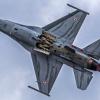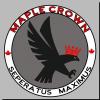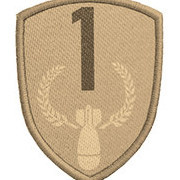Leaderboard
Popular Content
Showing most liked content on 08/04/2018 in all areas
-
6 pointsDid a little experiment...old 190A painted according to Tamiya's Fw-190A3 instructions.
-
5 points
-
4 pointsRockwell F-31K Mustang II - Grupo 6 de Caza, Fuerza Aerea Argentina, 2018 The X-31 experimental jet fighter was designed and built by Rockwell and Messerschmitt-Bölkow-Blohm as part of a joint US/Germany 'Enhanced Fighter Maneuverability' programme to test thrust vectoring technology in both pitch and yaw allied to an advanced flight control system to provide controlled flight at very high angles of attack. Whilst being a radical new design the X-31 used a wide variety of parts from previous production aircraft including the F/A-18 Hornet front fuselage (including the cockpit, ejection seat and canopy) and the F-16 Fighting Falcon's landing gear plus the Cessna Citation's main landing gear wheels and brakes. This dramatically reduced the development time and risk by using flight-qualified components and enabled the first of just two X-31's to take to the air on October 11th, 1990 and over 500 test flights were flown between 1990 and 1995. With a huge fall in defence spending from the 'peace dividend' Rockwell began to look at ways of using many of the X-31's technologies in a low-cost fighter aircraft and in 1992 they proposed an 'F-31' version powered by a non-afterburning version of the General Electric F110 turbofan rated at 16,000lbs dry thrust. Deleting the thrust-vectoring and afterburner reduced a considerable amount of weight from the rear fuselage and Rockwell calculated that the lack of an afterburner would give the small and light F-31 such an increase in range that most missions could be flown without external drop tanks. On the home-front Rockwell proposed an A-31 version to supplement and eventually replace the A-10 Thunderbolt claiming that the A-31 would be about one-half of the cost of the proposed A-16 Fighting Falcon. But Rockwell's main efforts were on the export market and especially the Gulf States and Saudi Arabia and it was interest from the latter and also South Korea that encouraged Rockell to proceed with development at the end of 1993. Marketing their new fighter as the 'F-31 Mustang II' orders were placed by South Korea (72) and Saudi Arabia (59) followed by a home order of 30 aircraft for the US Navy to supplement their F-5E Aggressor Force and then 100 A-31C's for the US Air Force. In December 1998, the Royal New Zealand Air Force became the third export customer when they placed an order for 34 F-31K's to replace it's ageing Skyhawks but the acquisition was cancelled by the new Labour government in March 2000 in a controversial move as "an air combat force is not a priority in the current benign security environment". With most of the F-31K's having already rolled off the production line Rockwell did not take the cancellation lightly and, faced with huge cancellation charges, the New Zealand government breathed a sigh of relief when the Argentinian Government, led by Fernando de la Rúa, negotiated the purchase of the 34 F-34K's for the Fuerza Aerea Argentina at a reduced price. Entering service with Grupo 6 de Caza in August 2001 the F-31K's continue in service based at the Tandil Military Air Base in the Buenos Aires Province. Skin Credit: Gepard
-
4 points
-
3 pointsUkroboronprom UV-1 Merlin - 39th Tactical Aviation Squadron, Ukrainian Air Force, 2018 The 'National Reorganization Process' was the rather grand name used by it's leaders for the military dictatorship that ruled Argentina from 1976 to 1983 following the coup d'état of March 1976 and towards the late 1970's the military junta started an ambitious project to create three indigenous combat aircraft consisting of the FMA IA 63 Pampa trainer/attack aircraft, the IA 67 Córdoba light attack bomber and the SAIA 90 air superiority fighter. By 1980, FMA (Fabrica Militar de Aviones) and Dornier had already developed a working relationship as a result of their combined development of the FMA IA 63 and for the SAIA 90 they established a second project office in the city of Córdoba for the development, production and marketing of a new fighter aircraft design based on a preliminary design by Dornier which could then be adapted by FMA to the requirements of the Argentine Air Force. Dornier's design bore an overall likeness to the F/A-18 Hornet but featured a trapezoidal wing shape and was smaller overall and considerably lighter thanks to an even higher composite content. FMA estimated a lengthy development period of about10 years with a first flight of the prototype in 1989 and with deliveries following about two years later and this was judged to be acceptable. However, by 1981 FMA was in serious financial difficulties which led to Dornier exiting the partnership leaving FMA desperately searching for new partners during 1981 to 1983 including Aermacchi-Aeritalia, McDonnell Douglas and Fairchild but Argentina's severe financial problems saw the project placed on indefinite hold by President Raúl Alfonsín in January 1984. Despite this, the Chiefs of the General Staff of the Argentine Air Force secretly diverted funds from other areas of their budget into the project to keep the SAIA 90 alive during the hyperinflation of the late 1980's. In July 1989 the incoming President Carlos Menem promised to strengthen the Argentine Armed Forces and successfully tackled inflation with the 'Convertibility Plan' allied to a series of privatisations allowing him to announce on July 9th, 1992 that the SAIA 90 project would be relaunched as an indigenous project called ACA'96 (Avión de Combate Avanzado 1996) to replace the fighter fleet before the turn of the century. The Belavezha Accords of December 1991 declared that the Union of Soviet Socialist Republics effectively ceased to exist and established the Commonwealth of Independent States as a successor entity. From this promising new beginning, relations between Russia and the Ukraine slowly deteriorated with disputes over the Crimea and then the city of Sevastopol due to it's role of being the home port of the Black Sea Fleet. Finally, a major dispute flared up over energy supplies and the Ukraine's huge gas debt arrears to Russia were paid off by the transfer of the nuclear-capable weapons that Ukraine inherited from the USSR and the Tu-160 strategic bombers and Su-27 fighters. During 1994 the Ukrainian Government sought a multi-role fighter aircraft that would not align them to either Russia or the West and identified the promising FMA ACA'96 design as being the best choice and opened up diplomatic talks with the Argentinian Government about licence-production of the ACA'96 in the Ukraine. With the Argentinian economy on another downward spiral agreement was quickly reached and the Kharkiv State Aviation Manufacturing Enterprise (later part of Ukroboronprom) was selected as the production facility but with all development and testing continuing to be done in Argentina. The prototype ACA'96, by now designated as the FMA IA 96, took to the air on May 25th, 1996 and finally entered service with the Argentine Air Force on November 20th, 1999. In Ukrainian service the aircraft is designated as the UV-1 'Merlin' and production aircraft entered service in 2002 with the 39th Tactical Aviation Squadron based at Vasylkiv, Kiev Oblast in Central Ukraine. Skin Credit: torno
-
3 points
-
2 points
-
2 points
-
1 pointis the cockpit opening effect on this spawn, the portal and the e.t. gray are tga textures taken to (self illumination) in the 3dmax so that they shine in the dark. and everything in reality is a Mogul balloon
-
1 point
-
1 pointF-35A, 21st Tactical Aviation Base, Polish Air Force, 2022 Conducting a joint task force operation over Dhimar
-
1 point
-
1 pointI'd forgotten how much fun it is to "Blow $h&t Up" with a Canberra. Until people try and shoot you to pieces.
-
1 point
-
1 pointOn this date, 27 July 1972, the McDonnell Douglas F-15A Eagle (Serial Number 71-0280) took to the air for the first time over the desert at Edwards AFB, California. (As a side note: today is also my wedding anniversary) 46 years later, with thousands of sorties flown, only 4 have been lost to enemy action and it's air to air combat record is over 100 to ZERO, the best of ANY combat aircraft in history!
-
1 point
-
1 point
-
1 point
-
1 point
-
1 point
-
1 pointThe BM and SM on the Fitter is great some other SF2 action, what a great compilation of planes we have later i was shot down, but who cares
-
1 pointl'aéro Cusp Whee And around we go Just Buzzing Bringing sexy back
-
1 point
-
1 point
-
1 point
Important Information
By using this site, you agree to our Terms of Use, Privacy Policy, and We have placed cookies on your device to help make this website better. You can adjust your cookie settings, otherwise we'll assume you're okay to continue..




















